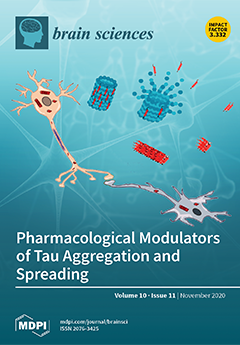Arterial ischemic stroke (AIS) in childhood is reported to occur more frequently in boys, which may lead to the assumption that the prevalence of post-stroke deficits is sex related. The present study aimed to evaluate sex-related differences in functional outcomes (hemiparesis, seizures, aphasia,
[...] Read more.
Arterial ischemic stroke (AIS) in childhood is reported to occur more frequently in boys, which may lead to the assumption that the prevalence of post-stroke deficits is sex related. The present study aimed to evaluate sex-related differences in functional outcomes (hemiparesis, seizures, aphasia, and motor disturbances other than hemiparesis) in pediatric patients with AIS. A total of 89 children (52 boys and 37 girls; mean age at stroke onset: 8.4 ± 5.6 years) were evaluated retrospectively based on data from medical records. The patients were divided into subgroups according to age (i.e., infants and toddlers, children, and adolescents), stroke subtype (i.e., lacunar anterior circulation infarct (LACI), total anterior circulation infarct (TACI), partial anterior circulation infarct (PACI), posterior circulation infarct (POCI)) and stroke location (i.e., anterior stroke, posterior stroke). Significant differences in the prevalence of stroke subtypes between girls and boys were observed (
p = 0.034). POCI stroke were found to be more frequent in boys than in girls (OR = 8.57 95%CI 1.05–70.23,
p = 0.023). Males predominated in the total group and in all analyzed age subgroups. The proportions of boys within the subgroups according to stroke subtype were extremely high for the POCI and TACI stroke subgroups. On the other hand, girls predominated in the LACI stroke subgroup. Frequency of central type facial nerve palsy and other symptoms of AIS were found to significantly differ between male subgroups according to stroke subtype (
p = 0.050 and
p < 0.001, respectively), as well as between children with anterior stroke and those with posterior stroke (
p = 0.059 and
p < 0.001, respectively). Post-stroke seizures appeared significantly more commonly in girls with TACI and POCI stroke than in girls with LACI and PACI stroke (
p = 0.022). In turn, the prevalence of post-stroke hemiparesis differed between stroke subtypes in boys (
p = 0.026). In conclusion, sex may have an impact in predisposing to a certain type of AIS in the patient. Post-stroke seizure may be related to stroke subtype in girls and hemiparesis in boys. However, further studies are needed to confirm the results.
Full article






